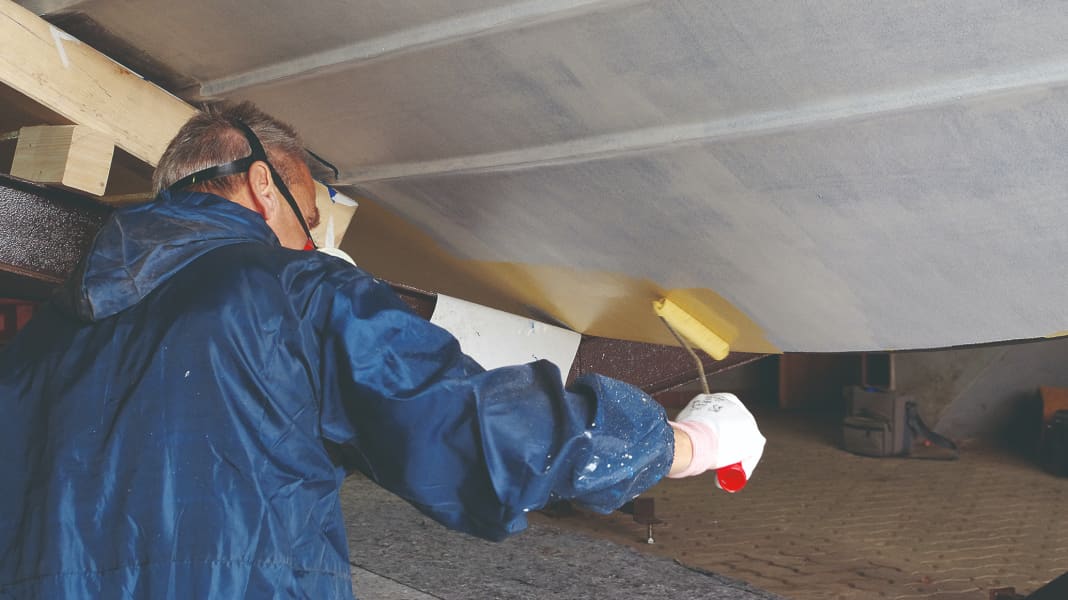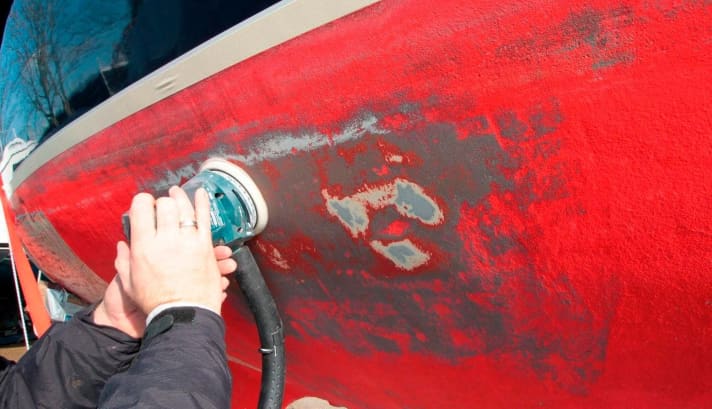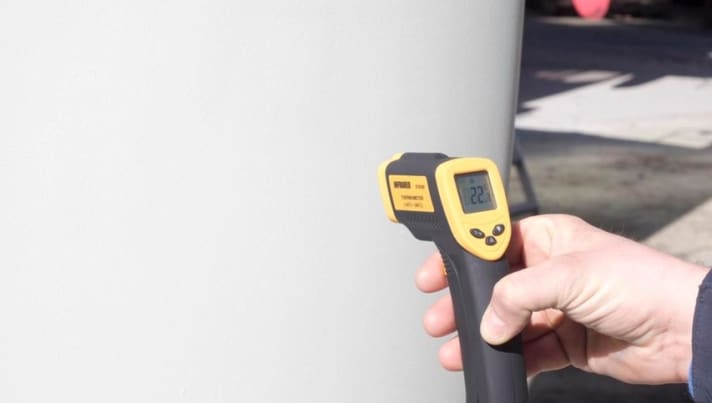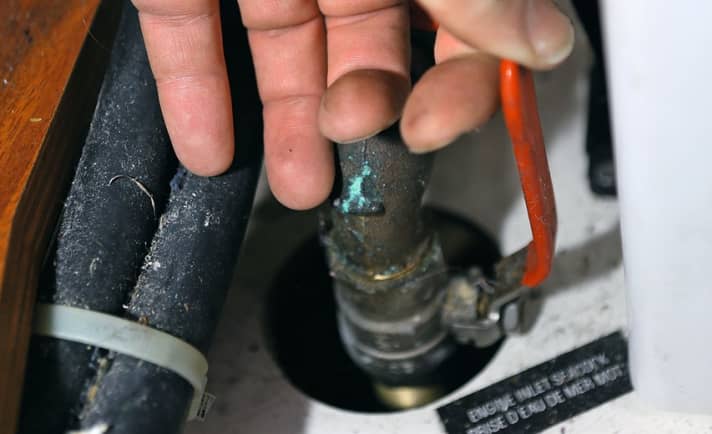
This article is part of the special season start. All parts:
- Cast off - how to get the new season off to a smooth start
- Checklist: Fit for the new season - the checklist
- Cleaning, polishing and care
- The best care and cleaning products for boats
- Last-minute tips from the experts at Pantaenius for the start of spring
- Checklist for the boat trailer
- The best tips from the Pantaenius specialist
- Changing the oil in a boat engine - here's how!
- Special pumps - changing oil in no time at all
- To check the cooling circuit
- How to renew the antifouling
- Boat equipment - the more, the better
The underwater hull should be thoroughly cleaned in autumn. This can be done with a high-pressure cleaner, but you should be very careful when doing so, otherwise you will not only shoot down the fouling and pockmarks, but also the antifouling.
This applies in particular to self-polishing antifouling, which can thin out very quickly during high-pressure cleaning. It is therefore better to clean mechanically with an abrasive pad.
Particular attention should be paid to the water pass area, where the dirt is heaviest. Soap or other grease-dissolving agents such as washing-up liquid should be used there.
Autumn is also the best time to check your boat for possible osmosis damage. This involves inspecting the hull for blistering, which is most pronounced in autumn. The boat has been in the water for around six months and has absorbed water. If a decomposition reaction has started, the osmosis bubbles are at their maximum size at this time and are best recognised.

Over the winter months, the liquid diffuses back out through the gelcoat, the pressure in the bubbles decreases and it may be that in spring there is nothing left to see. The owner may then diligently sand the entire underwater hull and only then realise that there is osmosis damage. Then all the work was for nothing, because the antifouling would be blasted off during an osmosis treatment anyway. The best way to detect osmosis is to use sunlight as a grazing light or generate it with a torch. The bubbles cast shadows and are very easy to recognise. If you find any, it is best to consult a specialist.
Why do you need antifouling?
If you take your boat out of the water after every stroke, you're in the clear because you don't need to worry about fouling. As soon as the boat stays in the water for longer, it's a different story. The underwater hull must be protected from colonisation by algae and organisms to prevent the yacht from suddenly becoming a property covered in mussels and pox.
How quickly the fouling colonises depends on various factors - mainly the territory and the climatic influences on water temperature and salinity as well as the nutrient supply. User behaviour also plays a role. If the boat is stationary for a long time, it will colonise more quickly than a frequently moving and fast-moving vessel.





But even constant driving does not protect against fouling. At some point, a biofilm forms that is difficult to wash off by the incoming current. This serves as the basis for further colonisation by smallpox and mussels. There are several strategies to prevent their spread. The classic approach is to use biocides, i.e. toxic substances that kill the colonisation.
- Which antifoulings are suitable for which areas can be found in the Fouling atlas of the Federal Environment Agency to read
Preparing the underwater hull for antifouling
If you have neglected to clean in the autumn, you will have to do even more preparatory work in the spring. Normally, self-polishing antifouling does not require sanding before a fresh coat is applied. However, if the algae growth was not removed in the autumn, it now lies on the antifouling as a dried layer. Sanding is usually the only way to prevent it from coming off later.

The basic rule for self-polishing antifouling is: as long as there is antifouling on the hull, it will work. So if the old antifouling layer is still intact, there is no reason to paint over it - it is harmful to the environment and costs money and time.
The only problem is recognising whether there is still enough antifouling. One trick is to work with different colours. For example, the painting professionals at Peter Wrede GmbH in Wedel near Hamburg spray the first coat of antifouling in green, and only then apply the actual top coat in the recommended thickness. As long as no green is visible, there is no need to repaint. The professionals call this process a colour indicator.
This can also be recreated with existing antifouling by painting the first coat a light grey and then the final colour. However, this is only possible if the first coat is also an antifouling. A primer of a different colour is not suitable. Because as soon as this is visible, there is no more antifouling on the hull and it becomes overgrown.
Unlike self-polishing antifouling, hard antifouling must always be sanded when it is used up and needs to be reapplied. Antifouling should be applied with a foam roller or a short-haired mohair roller. It is better to apply two thin coats than one thick coat. Bring the can of paint to room temperature beforehand and stir well.
Note the dew point when applying antifouling

When applying antifouling, care should be taken to ensure that the dew point is not exceeded. An owner will never have the same ideal conditions as a profile painter, for example, but he can at least avoid major mistakes. This means that the hull must always be at the same temperature as the ambient air or warmer. If the hull is colder than the air, the moisture in the air will condense on it and the antifouling will be applied to a film of moisture. This can lead to poor adhesion and later to peeling. The best conditions are usually in the afternoon, when the temperature drops again but the hull is still warm from the day. Applying antifouling in the morning will definitely go wrong. This is because the hull is still cold from the night, but the air warms up more quickly and the boats sweat.
The temperature difference between the hull and the air can also be easily measured using a laser thermometer from a DIY store for the hull and a normal thermometer for the air. However, don't just measure the hull, but also the keel, if there is one, because it heats up more slowly. If you have the opportunity to take the boat outside when applying antifouling, you should do so, or at least open the hangar door. This allows the hull to dry better and also allows the solvents to evaporate more easily.
What else do you need to look out for?
Seacocks and hoses: According to insurance broker Pantaenius, a classic case of damage is valves left open from which the hose slips off or leaks due to signs of ageing. You should ask yourself the following questions:

Have the hoses become hard? This should also be checked in autumn. Then they should be replaced. Are all hoses firmly connected to the respective valve, have two hose clamps been used everywhere? Are the seacocks all in good working order? It is essential to check the sea valves for corrosion from the outside, as this can only be detected from the outside. This will also reveal any impurities that could cause the machine to overheat, for example.
A valve plan is a good way of knowing where each sea valve is located at all times.
Checklist underwater hull
- Pox and algae growth
- Damage
- Osmosis
- Antifouling adhesion
- Apply new antifouling
- Corrosion on the keel
- Seacocks
- Hoses on valves
- Clean encoder from log and plummet
- Visual inspection of the stuffing box, shaft play.
This article is part of the special season start. All parts:
- Cast off - how to get the new season off to a smooth start
- Checklist: Fit for the new season - the checklist
- Cleaning, polishing and care
- The best care and cleaning products for boats
- Last-minute tips from the experts at Pantaenius for the start of spring
- Checklist for the boat trailer
- The best tips from the Pantaenius specialist
- Changing the oil in a boat engine - here's how!
- Special pumps - changing oil in no time at all
- To check the cooling circuit
- How to renew the antifouling
- Boat equipment - the more, the better

